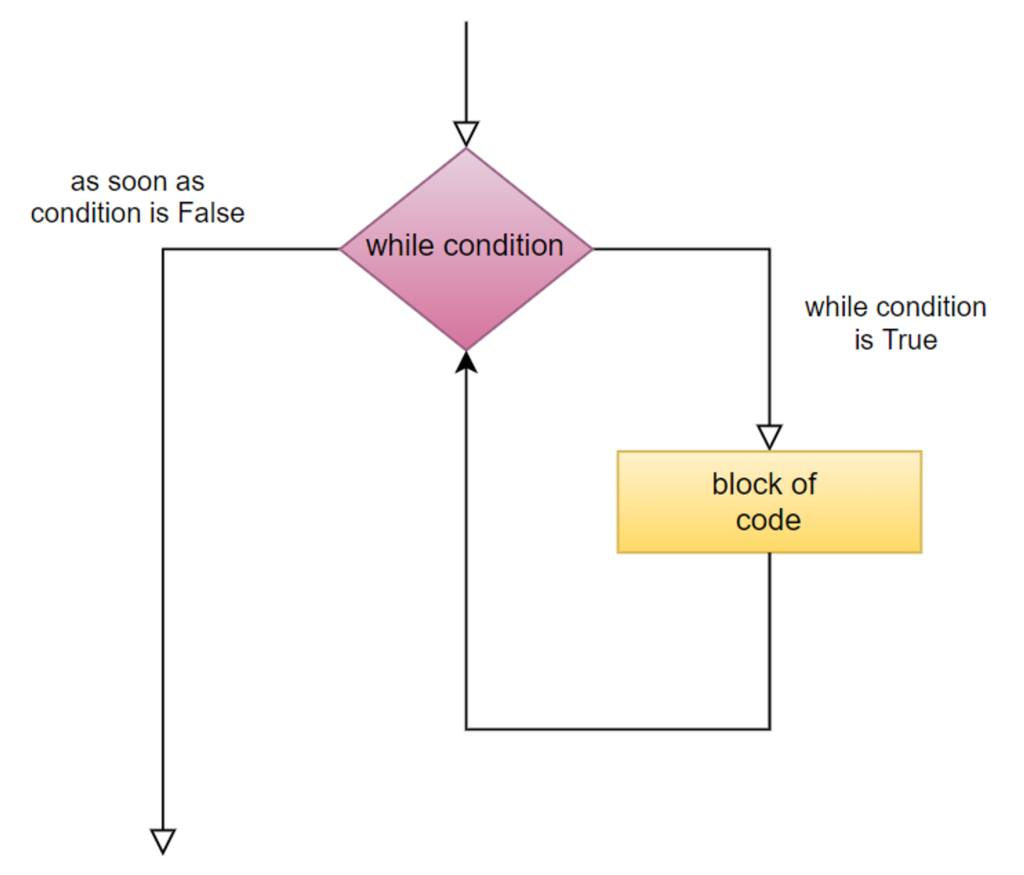Imagine you have a box of chocolates, and you want to give one chocolate to each friend at a party. You can use a for loop to help you do this, or alternatively, a while loop in Python.
Here’s how it works:
- You start by saying “for each friend at the party, give them a chocolate.”
- Then you give one chocolate to each friend.
- You repeat step 2 until you’ve given a chocolate to each friend at the party.
So, if you had 5 friends at the party, the for loop would help you give one chocolate to each friend until you’ve given chocolates to all 5 friends.
In code, it would look something like this:
friends = ["Alice", "Bob", "Charlie", "David", "Emma"]
for friend in friends:
print("Giving a chocolate to", friend)This code would print:
Giving a chocolate to Alice
Giving a chocolate to Bob
Giving a chocolate to Charlie
Giving a chocolate to David
Giving a chocolate to EmmaEach friend gets a chocolate, just like in real life!
Python while Loop
As the name suggests, while loops execute statements while the condition is True. As soon as the condition becomes False, the interpreter comes out of the while loop.

Example:
count = 5
while (count > 0):
print(count)
count = count - 1Output:
5
4
3
2
1Here, the count variable is set to 5 which decrements after each iteration. Depending upon the while loop condition, we need to either increment or decrement the counter variable (the variable count, in our case) or the loop will continue forever.
We can even use the else statement with the while loop. Essentially what the else statement does is that as soon as the while loop condition becomes False, the interpreter comes out of the while loop and the else statement is executed.
Example:
x = 5
while (x > 0):
print(x)
x = x - 1
else:
print('counter is 0')Output:
5
4
3
2
1
counter is 0Conclusion
In conclusion, while loops in python are a powerful programming feature used for repetitive execution of code based on a specified condition. They are particularly useful when the number of iterations is uncertain or depends on dynamic conditions. By carefully crafting the condition and updating variables within the loop, developers can create efficient and flexible algorithms to tackle various tasks in programming. However, it’s crucial to be cautious when using while loops to avoid potential pitfalls like infinite loops, ensuring that the loop terminates as expected based on the specified condition.
Frequently Asked Questions
Ans: A while loop is a programming construct that repeatedly executes a block of code as long as a specified condition is true.
Q2. How does a while loop work?
Ans: A while loop starts by evaluating a condition. If the condition is true, the code inside the loop is executed. After each execution, the condition is checked again. If it’s still true, the loop continues; otherwise, the loop terminates.
Q3. What is the syntax of a while loop?
Ans: In most programming languages, the syntax for a while loop is: arduinoCopy code while (condition) { // Code block to be executed }
Q4. What are common use cases for while loops?
Ans: While loops are used when the number of iterations is not known beforehand and depends on some condition. They are commonly used for tasks like reading input until a specific condition is met, processing data until it satisfies certain criteria, or implementing game loops.
Q5. What are potential risks when using while loops?
Ans: One potential risk with while loops is creating infinite loops, where the loop’s condition never becomes false. This can lead to the program becoming unresponsive or crashing. It’s essential to ensure that the condition in a while loop eventually becomes false to avoid this issue

